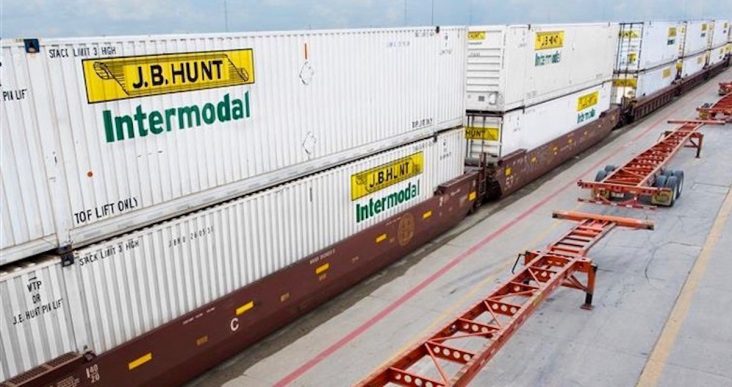J.B. Hunt tops quarterly estimates; revenue, earnings up double digits
by October 18, 2022 5:51 pm 899 views

Lowell-based carrier J.B. Hunt Transport Services Inc. beat analyst estimates for third quarter earnings and revenue as freight demand continued to exceed expectations. However, company executives noted caution in the market, a softer-than-expected peak season and customers’ inventory issues.
After the markets closed Tuesday (Oct. 18), the carrier reported earnings increased by 34.8% to $269.38 million, or $2.57 per share, from $199.82 million, or $1.88 per share, in the same period last year. Revenue rose by 22.1% to $3.83 billion, from $3.14 billion.
J.B. Hunt beat earnings expectations of $2.45 per share, based on a consensus of 24 analysts. The carrier also beat the average revenue estimate of $3.8 billion.
In a third-quarter research brief, analysts Justin Long and Jack Atkins, and associate Brady Lierz, all of Little Rock-based Stephens Inc., said the carrier’s results were “better than feared” and noted that a lower-than-expected tax rate was a 7-cent tailwind. The beat could be attributed to the intermodal and dedicated segments and partially offset by shortfalls in the brokerage, truckload and Final Mile Services segments.
The analysts said as expected the intermodal volumes were lower because of challenging rail service and fluidity, while intermodal yield and margins outperformed. They said the most notable shortfall was in the brokerage segment, with volumes down 8% from the same period in 2021 and operating income down from the second quarter.
In a third-quarter conference call, J.B. Hunt execs expressed an increased level of caution in the market, while remaining optimistic about growth opportunities. President Shelley Simpson said the third quarter was the company’s best but was muted amid the caution. She said the caution is the company’s readiness to pivot and that it understands its customers.
Darren Field, president of intermodal, said peak season volumes have been weaker than what was projected several months ago. Field explained that rail volumes were affected because of the possible rail strike in September but have since recovered. He also said that customers have elevated inventories and are trying to find a place to put goods.
According to a news release, the carrier attributed the revenue increase to a 17% rise in intermodal revenue per load, an 18% increase in average revenue producing trucks in its dedicated segment, a 13% increase in truckload volume and a revenue rise in Final Mile Services that was attributed to a recent acquisition. The revenue increase was partially offset by an 8% decline in brokerage volume.
The carrier’s operating income rose because of customer rate and cost-recovery efforts and higher volumes in the dedicated, brokerage and truckload segments, compared to the same period last year. The increase was partially offset by higher rail and truck purchased transportation costs, increased labor costs, rising equipment-related and maintenance costs and costs associated with inefficiencies in intermodal container use and the onboarding of new business in dedicated and Final Mile Services.
Freight transactions attributed to the Marketplace for J.B. Hunt 360, the carrier’s digital platform, rose by 7% to $552 million in the third quarter, from $519 million in the same period last year.
Through three quarters, the company’s earnings increased by 48.1% to $768.04 million, or $7.28 per share, from $518.59 million, or $4.86 per share, in the same period last year. Revenue rose by 28.8% to $11.16 billion, from $8.67 billion.
Shares of J.B. Hunt (NASDAQ: JBHT) closed Tuesday at $167.89, up $2.14 or 1.29%. In the past 52 weeks, the stock has ranged from $153.92 to $218.18.
SEGMENT NUMBERS
Following are third-quarter results by segment:
• Intermodal
Operating income increased to $216.99 million, from $165.09 million. Revenue rose to $1.83 billion, from $1.41 billion.
• Dedicated
Operating income rose to $103.07 million, from $78.13 million. Revenue rose to $893.99 million, from $664.76 million.
• Brokerage
Operating income fell to $13.51 million, from $14.74 million. Revenue declined to $590.97 million, from $666.21 million.
• Truckload
Operating income rose to $19.03 million, from $14.66 million. Revenue rose to $273.56 million, from $203.6 million.
• Final Mile Services
Operating income increased to $9.61 million, from $1.27 million. Revenue rose to $249.36 million, from $205.9 million.
BROADER TRENDS
American Trucking Associations’ advanced seasonally adjusted For-Hire Truck Tonnage Index rose 5.5% in September, from the same month in 2021. The index was up by 0.5% in September, from August. Between January and September, the index has risen by 4% from the same period in 2021.
“The latest gain put tonnage at the highest level since August 2019 and the third highest level on record,” said ATA Chief Economist Bob Costello. “This is another example of how the contract freight market remains strong despite weakness in the spot market this year. During the third quarter, tonnage increased 0.5% over the second quarter while increasing 5.6% over the same period in 2021. That was the largest quarterly year-over-year increase since the second quarter of 2018.”
The shipments component of the Cass Freight Index rose by 4.8% in September, from the same month in 2021. But it was down by 2.9% in September, from August. According to the Cass Transportation Index Report, “U.S. freight volumes continued to exceed low expectations in September with more buoyant demand than feared in the start of peak shipping season.”
The report attributed the rise to retail discounting to clear excess inventories, seasonal inventory building before the holidays, repositioning mistimed inventory, easing supply chain constraints, especially in auto production, and easier comparisons to 2021.
In October, growth is expected to slow to 2%-3% on a tougher comparison, according to the report. In the fourth quarter, the shipments component of the index is expected to be down or flat amid tougher comparisons in November and December.
